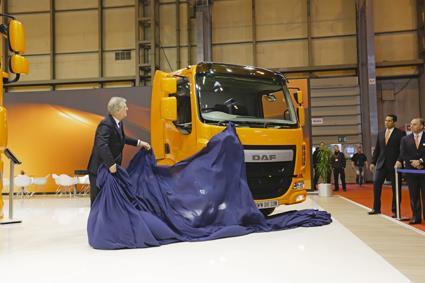
With Mercedes giving its latest Atego its first public airing in Birmingham this week and Daf Trucks choosing the NEC for the world debut of its new LF and CF ranges, the CV Show packs more clout than usual this year.
Sure, it’s a long way from the sprawling behemoth that is the IAA commercial vehicle show in Hannover, but trade journalists from elsewhere in Europe have journeyed to Birmingham, giving it just a hint of the international flavour that has been lacking in the past.
But the glitz of the occasion fails to mask what is a rather confusing truck market. For example, most of the trucks on display are Euro-6 models and yet we are repeatedly told that so far, operator interest in Euro-6 is lukewarm at best.

With time fast running out to order the last Euro-5 trucks, maybe the CV Show is a turning point. Daf Trucks’ UK managing director Ray Ashworth sums up this rather surreal situation.
“People will really believe that Euro-6 is here,” he says. “The CV Show is the perfect shop window for it. But as soon as the show is over we will go back to selling and building Euro-5 trucks as fast as we can until the end of the year. There is absolutely no business case for buying a Euro-6 truck now.” Daf’s Euro-6 price hike, averaging 15%, explains that.

According to market analysts, this aversion to Euro-6 and a determination to secure late Euro-5 models instead will drive up UK registrations of new trucks over 6-tonnes GVW by 8%-10% this year, taking them from 38,600 to around 42,000.
And yet registrations in the first quarter are running 15.5% behind last year, so if the growth forecasts are to prove correct we are about to witness a 17% surge in registrations during the next nine months.
However, given that the UK economy is flatlining at best, and possibly teetering on the brink of a triple-dip recession, are truck operators really prepared to make such a large commitment to fleet renewal? According to Ashworth, the answer is yes, and he sees Daf’s order book, so he should know. “I am confident that we will reach at least 41,000 this year,” he says.
Chief executive of MAN Truck & Bus UK Des Evans, pictured, sees things differently, commenting that the year-end registration total might not even start with the figure ‘4’. “April and May is decision time,” declares Evans.
Pointing out the bodybuilding industry has a finite capacity, he warns that if orders do not come in during the next two to three months, this year’s truck market is going to be “very, very low”.

This is not a glitch, reckons Evans, it is more like a sign of things to come. He forecasts that truck sales will settle at a lower level because we are poised to see what he calls a truck’s
primary life shifting from the current four or five years, to six or seven years.
He envisages that the truck’s first owner will keep it for a million kilometres, or a half a million in the case of a rigid. “We design these trucks for a life of 1.5 million kilometres, so why not fund and operate them over a million kilometres? This is what I believe is going to happen,” declares Evans.
Radical stuff. Keeping trucks for seven years. Hold on – isn’t that what we used to do before truck manufacturers and their finance arms convinced us that it made sense to switch to three-year contract hire deals?
But Evans is not planning to sell us a truck and then wave goodbye to us for another seven years. He wants to sell us the use of the truck, and its supporting services, taking out the variables for seven years. “We can give you a fixed cost per kilometre, for a million kilometres,” he says.
For operators wary about the implications of Euro-6, maybe this sort of long-term fixed cost deal sounds attractive, although Evans says that MAN’s Euro-6 repair and maintenance contract rates will be no more than Euro-5’s.

Reverting to a seven-year first life would have a major impact on today’s plentiful supply of youthful used trucks, but Evans has thought of that too. He explains that MAN’s rental operation has more than trebled in fleet size over the past two years. “It’s our used truck factory,” quips Evans.











